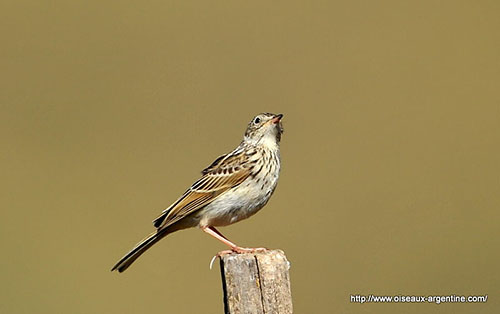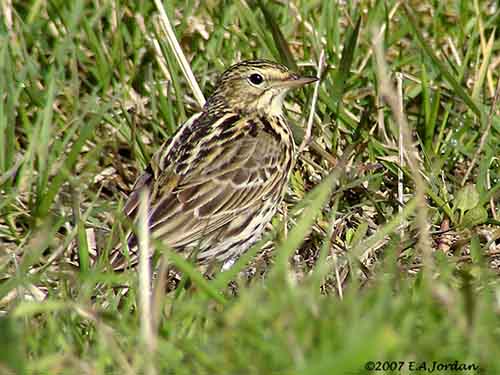
Fr: Pipit correndera
All: Correnderapieper
Esp: Bisbita Correndera
Ita: Pispola di Correndera
Nd: Correnderapieper
Sd: Correnderapiplärka
Port: Caminheiro-de-espora
Photographers:
John Anderson
John Anderson Photo Galleries
Eduardo Andrés Jordan
MIS AVES – AVES DE ARGENTINA
Philippe et Aline Wolfer
GALERIE
Text by Nicole Bouglouan
Sources:
HANDBOOK OF THE BIRDS OF THE WORLD Vol 9 - by Josep del Hoyo - Andrew Elliot - David Christie - Lynx Edicions - ISBN: 8487334695
BIRDS OF SOUTH AMERICA – Passerines - by Robert S. Ridgely and Guy Tudor – HELM Field Guides – ISBN: 9781408113424
BirdLife International (BirdLife International)
Birding Patagonia – Adventure expeditions
Correndera Pipit
Anthus correndera
Passeriformes Order – Motacillidae Family
INTRODUCTION:
The Correndera Pipit is known as the most boldly marked South American pipit, with conspicuous black spotting on the underparts. Like all pipits, it is difficult to identify in the field, but this one shows two longitudinal white stripes down the back, that helps to recognize this species.

DESCRIPTION OF THE BIRD:
Biometrics:
Length: 14-16 cm
Weight: 20 g
The adult of nominate race has dark upperparts with heavy cinnamon-buff streaking. There are two longitudinal white stripes on each side of the mantle. The upperwing is dusky with edged-white primaries, and buffy-white edges to wing-coverts, forming two pale wingbars. The tail is dark with pale outer rectrices.
On the buffy-white underparts, the breast is heavily spotted black, and flanks are streaked black.
On the head, crown, ear-coverts and hindneck are ochraceous streaked black. We can see a whitish supercilium and white eyering, and narrow blackish moustachial and malar stripes.
The bill is black with pale base of lower mandible. The eyes are dark brown. Legs and feet are pinkish-brown, with almost straight hind claw.
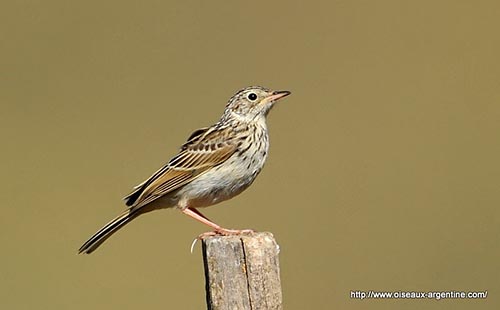
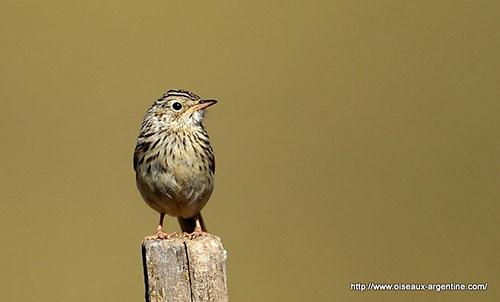
Both sexes are similar.
The juvenile has yellowish supercilium. On the upperparts, the feathers are edged whitish and the primaries are edged yellow. Wingbars are white.
SUBSPECIES AND RANGE:
We can find five subspecies:
A.c. calcaratus is found in Peruvian mountains. This race is darker than nominate, with tinged cinnamon upperparts and rufous rump, whereas the underparts are buff.
A.c. catamarcae occurs in N Chile, SW Bolivia and NW Argentina. This one has darker upperparts with more rufous rump than previous.
A.c. correndera (here described) is found in S Paraguay, N Argentina, Uruguay and extreme SE Brazil
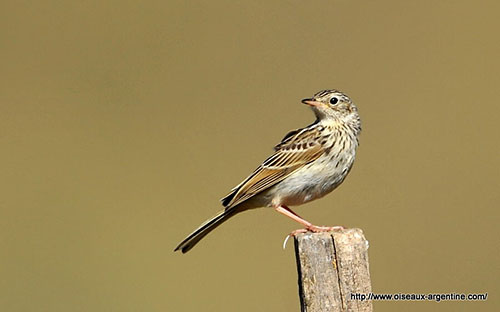
A.c. chilensis occurs in Chile and S Argentina, S to Tierra del Fuego. It is darker and buffer than nominate, with less heavy streaking on breast, but extending to upper belly.
A.c. grayi is restricted to Falkland Islands. This one is larger than nominate. It has stronger bill and smaller streaks on breast. It is locally named “Falkland Pipit” or “Skylark”.
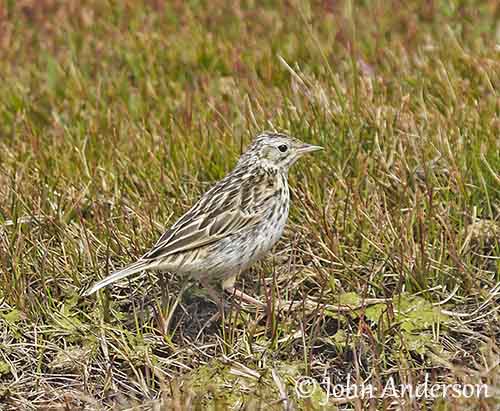
HABITAT:
The Correndera Pipit occurs in temperate grassland, pastures and cultivated areas, rocky areas in mountains, along freshwater streams and lakeshores with short grass and clumps of rushes. It can be seen between 2500 and 4450 metres of elevation.
In Falkland Islands, it frequents open grassland and open coastal areas, but it avoids the thick tussock grass areas.
CALLS AND SONGS: SOUNDS BY XENO-CANTO
The Correndera Pipit’s flight call is a harsh « trrrit » and some variant.
The song is conspicuous during the breeding season, uttered during the aerial displays while the male rises into the air, hovers into the wind and repeats musical phrases “glishawa-glishawa, gleeweeeer… glishawa-glishawa, gleeweeeer…”. There is sometimes some variation, but with a distinctive final trill uttered while the bird is gliding down.
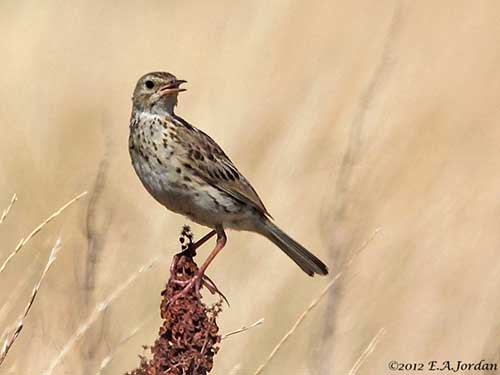
BEHAVIOUR IN THE WILD:
The Correndera Pipit spends most time on the ground while foraging for food. It feeds mostly on insects and larvae, and various invertebrates. Seeds are probably taken too.
In Falkland Islands, it feeds on a variety of invertebrates such as worms, grubs, moths and spiders.
It forages by walking and running easily on the ground, thanks to its strong legs and claws. They are mainly terrestrial feeders. It is usually seen alone or in pairs, often perched in open and looking around.
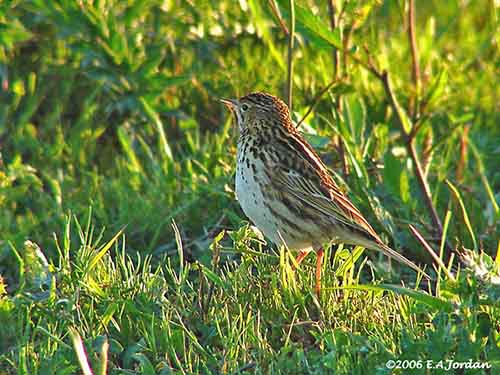
During the breeding season, it performs aerial displays accompanied by song. The male rises into the air and hovers into the wind, before to descend by glide with vibrating raised wings and tail. It rises up to 40 metres, hovers and glides down almost to the ground before climbing again. It sings while hovering or gliding down.
The Correndera Pipit is resident and partial migrant. The southernmost populations migrate N in April and return in September. The populations usually move N after breeding, although in C and S parts of the range, they may remain in their breeding grounds all year round. In Falkland Islands, the species is resident.
The flight is erratic and undulating.
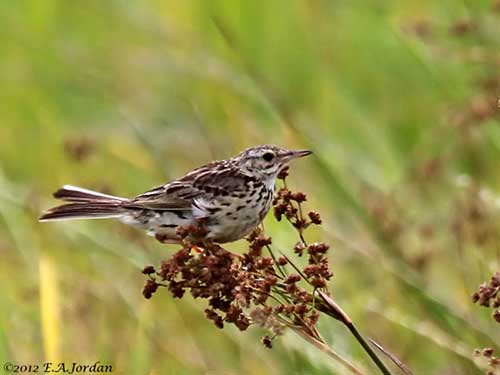
REPRODUCTION OF THIS SPECIES:
The breeding season occurs between June and December and between late September and December in Falkland Islands.
The Correndera Pipit usually produces two broods per season (2-3 in Falkland Is).
The nest is on the ground, a cup made with grass and rootlets and lined with soft materials such as feathers, wool and animal hair. It is placed in a depression, well hidden among clumps of grass. The female builds the nest while the male provides some material.
She lays 2-4 creamy-white eggs with darker spots. The incubation lasts about two weeks, mainly by female. The chicks are fed by both parents and fledge two weeks after hatching. They still depend on adults for food for about 20 days after fledging.
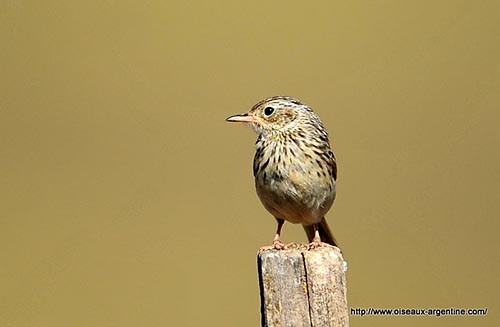
PROTECTION / THREATS / STATUS:
The Correndera Pipit is relatively common and widespread throughout the range, including the Falkland Islands (about 15,000 breeding pairs), but introduced cats and rats are a permanent threat on the islands. The world population is unknown.
Currently, the Correndera Pipit is evaluated as Least Concern.
